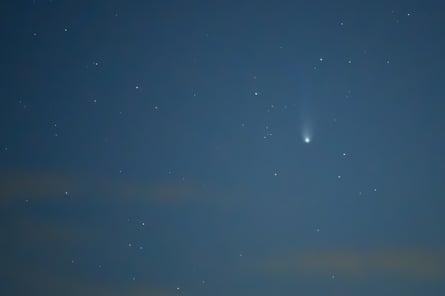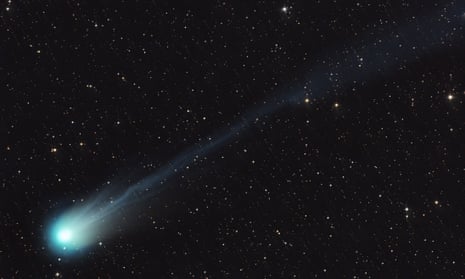The green, horned “Devil comet” is now visible in Australian skies, offering a once-in-lifetime chance to see a unique celestial body.
The comet – real name 12P/Pons-Brooks – was nicknamed the Devil comet because eruptions from its nucleus can make it look like it has two horns. More recently, Star Wars fans have nicknamed it the Millennium Falcon.
The comet, whose nucleus has a 34km diameter, has been likened to Halley’s comet because it passes by Earth about every 71 years. It also has a green tinge thanks to its molecular structure.
Halley’s comet appears about every 76 years, and was last visible in 1986, when amateur astronomers flocked outside at night to see it. It is often referred to as the most famous comet because, according to Nasa, it “marked the first time astronomers understood comets could be repeat visitors to our night skies”.
Brad Tucker, an astrophysicist at the Australian National University, said while the Devil comet is technically visible now, it’s tough to spot – but it will become clearer over the next week or so.
“It’s really low in the sky but it’s kind of right next to Jupiter, so if you can see Jupiter set in the western sky the comet is nearby.”
As it gets closer to the sunits icy core and gas trail becomes hotter, making it more visible. It will be at its brightest on 22 April, just above the horizon, but Tucker says it will be like “a cat and mouse game” to find it because by then it will be competing with a full moon.
“Probably the best day would be from around Anzac Day,” he said. “That’s past the full moon, but [the comet’s] still bright and it’s a bit higher … so the 25th, then into next weekend.”
Rebecca Allen, co-director of the Space Technology and Industry Institute at Swinburne University of Technology, said it will be visible to the naked eye but that it might help to spot it first with binoculars or a telescope. She said the comet had been spotted over centuries so it was a piece of history, but it is also special because of its brightness.

“As it’s made its journey in from the outer solar system, it’s heated up, so it’s released more gases,” she said. “There’s even a recorded explosion where it dramatically jumped in brightness.
“It’s green because of its diatomic carbon, a very rare form of carbon that’s unstable, so you only get it in very specific environments that don’t have oxygen – such as being on a comet.”
It has also been called the “Mother of Dragons” because it is cryovolcanic – a type of volcano that blasts water vapour and other materials out from the core.
“With the heat you get this pressure inside the comet and it releases this eruption,” Tucker said.
According to Nasa, people once perceived comets as “long-haired stars that appeared in the sky unannounced and unpredictably”. Now they are known to be “leftovers” from the formation of the solar system billions of years ago. They are comprised of ice and dirt and sometimes called “dirty snowballs”.
Allen said these comets, which have survived aeons and travelled from the edge of the solar system, are drawn in and eventually destroyed by the sun’s gravitational pull.
“They really are individual and as they get heated by the sun you just don’t know which ones will break apart,” she said.
“Each time they come in they lose a bit more mass. So there’ll be a final orbit when it does finally break up.”
